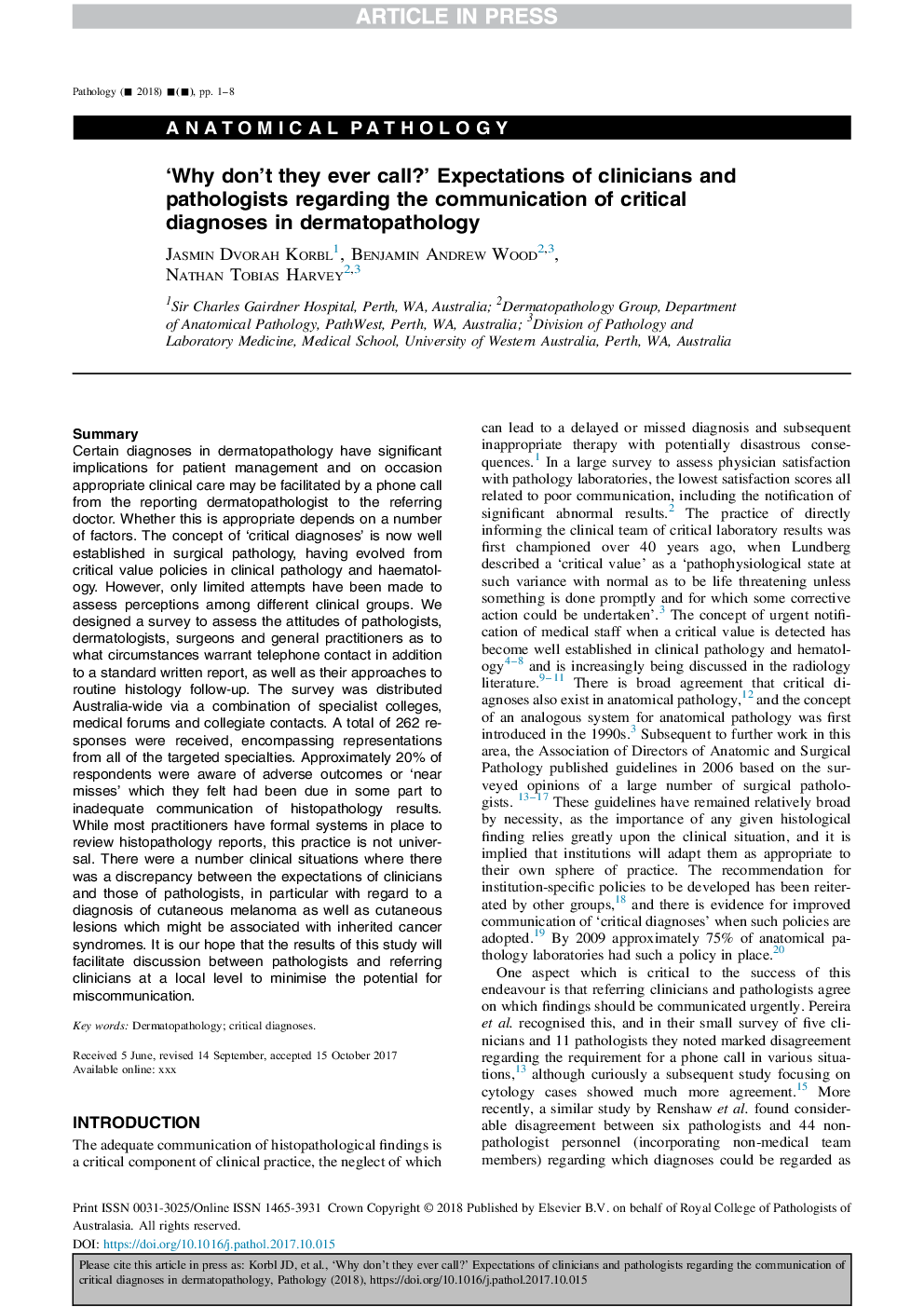| کد مقاله | کد نشریه | سال انتشار | مقاله انگلیسی | نسخه تمام متن |
|---|---|---|---|---|
| 6555512 | 1422484 | 2018 | 8 صفحه PDF | دانلود رایگان |
عنوان انگلیسی مقاله ISI
'Why don't they ever call?' Expectations of clinicians and pathologists regarding the communication of critical diagnoses in dermatopathology
ترجمه فارسی عنوان
چرا آنها هرگز تماس نمی دهند؟ انتظارات پزشکان و آسیب شناسان در ارتباط با تشخیص های بحرانی درماتولوژیست
دانلود مقاله + سفارش ترجمه
دانلود مقاله ISI انگلیسی
رایگان برای ایرانیان
کلمات کلیدی
درماتوپاتولوژی، تشخیص های بحرانی،
ترجمه چکیده
برخی از تشخیصهای درماتوپاتولوژی معاینات قابل توجهی برای مدیریت بیمار دارند و در صورت بروز یک تماس تلفنی از متخصص پوست به متخصص ارجاع، مراقبت مناسب بالینی ممکن است. این که آیا این مناسب است بستگی به تعدادی از عوامل دارد. مفهوم "تشخیص های بحرانی" در حال حاضر به خوبی در پاتولوژی جراحی، از سیاست های بحرانی ارزش در پاتولوژی بالینی و هماتولوژی، تکامل یافته است. با این حال، تلاش های محدودی برای ارزیابی ادراکات در میان گروه های بالینی مختلف صورت گرفته است. ما یک نظرسنجی برای ارزیابی نگرش های پاتولوژیست ها، متخصصین پوست، جراحان و پزشکان عمومی در مورد شرایط مطبوعاتی تلفنی علاوه بر یک گزارش کتبی استاندارد و نیز رویکردهای آنها برای پیگیری بافت شناسی معمول انجام دادیم. این نظرسنجی از طریق ترکیبی از کالج های تخصصی، انجمن های پزشکی و مخاطبین کالج در سراسر استرالیا توزیع شد. در مجموع 262 پاسخ دریافت شد، شامل نمایندگی از همه تخصص های هدف. تقریبا 20 درصد از پاسخ دهندگان از نتایج نامطلوب یا "نزدیک شدن به اشتباه" آگاه بودند که به نظر برخی از آنها ناشی از ارتباطات نامناسب نتایج هیستوپاتولوژی بود. در حالی که اکثر پزشکان سیستم های رسمی برای بررسی گزارش های هیستوپاتولوژی دارند، این عمل جهانی نیست. تعدادی از شرایط بالینی وجود دارد که در آن اختلاف بین انتظارات پزشکان و بیماران آسیب شناسی وجود دارد، به خصوص با توجه به تشخیص ملانوم پوستی و همچنین ضایعات پوستی که ممکن است با سندرم های ارثی سرطان مرتبط باشد. امید ما این است که نتایج این مطالعه بحث بین پاتولوژیست ها و ارجاع پزشکان در سطح محلی را برای به حداقل رساندن پتانسیل سوء تفاهم آسان تسهیل می کند.
موضوعات مرتبط
علوم پزشکی و سلامت
پزشکی و دندانپزشکی
پزشکی قانونی
چکیده انگلیسی
Certain diagnoses in dermatopathology have significant implications for patient management and on occasion appropriate clinical care may be facilitated by a phone call from the reporting dermatopathologist to the referring doctor. Whether this is appropriate depends on a number of factors. The concept of 'critical diagnoses' is now well established in surgical pathology, having evolved from critical value policies in clinical pathology and haematology. However, only limited attempts have been made to assess perceptions among different clinical groups. We designed a survey to assess the attitudes of pathologists, dermatologists, surgeons and general practitioners as to what circumstances warrant telephone contact in addition to a standard written report, as well as their approaches to routine histology follow-up. The survey was distributed Australia-wide via a combination of specialist colleges, medical forums and collegiate contacts. A total of 262 responses were received, encompassing representations from all of the targeted specialties. Approximately 20% of respondents were aware of adverse outcomes or 'near misses' which they felt had been due in some part to inadequate communication of histopathology results. While most practitioners have formal systems in place to review histopathology reports, this practice is not universal. There were a number clinical situations where there was a discrepancy between the expectations of clinicians and those of pathologists, in particular with regard to a diagnosis of cutaneous melanoma as well as cutaneous lesions which might be associated with inherited cancer syndromes. It is our hope that the results of this study will facilitate discussion between pathologists and referring clinicians at a local level to minimise the potential for miscommunication.
ناشر
Database: Elsevier - ScienceDirect (ساینس دایرکت)
Journal: Pathology - Volume 50, Issue 3, April 2018, Pages 305-312
Journal: Pathology - Volume 50, Issue 3, April 2018, Pages 305-312
نویسندگان
Jasmin Dvorah Korbl, Benjamin Andrew Wood, Nathan Tobias Harvey,
